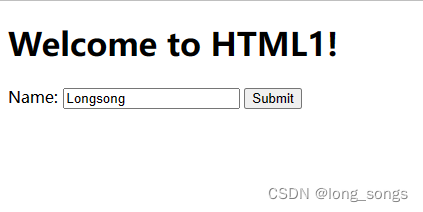URL传递、Cookie传递和Session传递都是常见的Web开发中用于传递数据的方式。它们各自有自己的优缺点,下面是它们的一些特点和适用场景:


URL传递:
- 优点:简单易用,不需要特殊技术,只需要使用URL即可传递数据;可以将数据传递给不同域名的页面,实现跨域传递数据。
- 缺点:URL中的参数有长度限制,一般为2KB左右,传递大量数据时不太适用;URL中的参数会显示在地址栏中,存在安全隐患。 适用场景:传递小量的数据,如页面之间的参数传递、搜索关键词等。
index.html
<!DOCTYPE html>
<html>
<head>
<meta charset="UTF-8">
<title>HTML1</title>
</head>
<body>
<h1>Welcome to HTML1!</h1>
<form method="get" action="receive.html">
<label for="name">Name:</label>
<input type="text" id="name" name="name">
<input type="submit" value="Submit">
</form>
<script>
// 获取表单元素和输入框元素
const form = document.querySelector('form');
const input = document.querySelector('#name');
// 在表单提交时将数据拼接到URL中
form.addEventListener('submit', (event) => {
event.preventDefault();
const url = new URL(form.action);
url.searchParams.set('name', input.value);
window.location.href = url.toString();
});
</script>
</body>
</html>receive.html
<!DOCTYPE html>
<html>
<head>
<meta charset="UTF-8">
<title>HTML2</title>
</head>
<body>
<h1>Welcome to HTML2!</h1>
<p>Name: <span id="name"></span></p>
<script>
// 获取URL中的参数
const params = new URLSearchParams(window.location.search);
const name = params.get('name');
// 将数据渲染到页面上
document.getElementById('name').textContent = name;
</script>
</body>
</html>Cookie传递:
index.html
<!DOCTYPE html>
<html>
<head>
<meta charset="UTF-8">
<title>HTML1</title>
</head>
<body>
<h1>Welcome to HTML1!</h1>
<form method="post" action="receive.html">
<label for="name">Name:</label>
<input type="text" id="name" name="name">
<input type="submit" value="Submit">
</form>
<script>
// 获取表单元素和输入框元素
const form = document.querySelector('form');
const input = document.querySelector('#name');
// 在表单提交时将数据保存到cookie中
form.addEventListener('submit', (event) => {
event.preventDefault();
document.cookie = `name=${input.value}`;
form.submit();
});
</script>
</body>
</html>receive.html
<!DOCTYPE html>
<html>
<head>
<meta charset="UTF-8">
<title>HTML2</title>
</head>
<body>
<h1>Welcome to HTML2!</h1>
<p>Name: <span id="name"></span></p>
<script>
// 获取cookie中的数据
const cookies = document.cookie.split(';');
let name = '';
for (let cookie of cookies) {
cookie = cookie.trim();
if (cookie.startsWith('name=')) {
name = cookie.substring(5);
break;
}
}
// 将数据渲染到页面上
document.getElementById('name').textContent = name;
</script>
</body>
</html>- 优点:可以存储大量数据,一般有4KB的存储空间;可以设置Cookie的有效期,长期保存数据;可以在客户端存储数据,减轻服务器的负担。
- 缺点:Cookie的存储和传输都需要消耗带宽和时间,会影响网络性能;Cookie中的数据可以被篡改或窃取,存在安全隐患。 适用场景:需要长期存储数据,如用户登录状态、购物车等。
Session传递:
index.html
<!DOCTYPE html>
<html>
<head>
<meta charset="UTF-8">
<title>HTML1</title>
</head>
<body>
<h1>Welcome to HTML1!</h1>
<form method="post" action="receive.html">
<label for="name">Name:</label>
<input type="text" id="name" name="name">
<input type="submit" value="Submit">
</form>
<script>
// 获取表单元素和输入框元素
const form = document.querySelector('form');
const input = document.querySelector('#name');
// 在表单提交时将数据保存到sessionStorage中
form.addEventListener('submit', (event) => {
event.preventDefault();
sessionStorage.setItem('name', input.value);
form.submit();
});
</script>
</body>
</html>receive.html
<!DOCTYPE html>
<html>
<head>
<meta charset="UTF-8">
<title>HTML2</title>
</head>
<body>
<h1>Welcome to HTML2!</h1>
<p>Name: <span id="name"></span></p>
<script>
// 获取session中的数据
const name = sessionStorage.getItem('name');
// 将数据渲染到页面上
document.getElementById('name').textContent = name;
</script>
</body>
</html>- 优点:可以存储大量数据,不受URL长度限制;可以设置Session的有效期,长期保存数据;数据只存储在服务器端,相对较安全。
- 缺点:Session的存储需要占用服务器的内存和计算资源,对服务器的性能有一定的影响;无法在客户端进行存储,可能会影响客户端的响应速度。 适用场景:需要长期存储数据,且需要保密性较高的数据,如用户登录状态、用户个人资料等。 总之,选择哪种方式传递数据,需要根据具体的需求和场景进行选择,权衡各种因素后再做决策。